Advocating to Secure Unprecedented Federal Resources (Cap-to-Cap 2024)
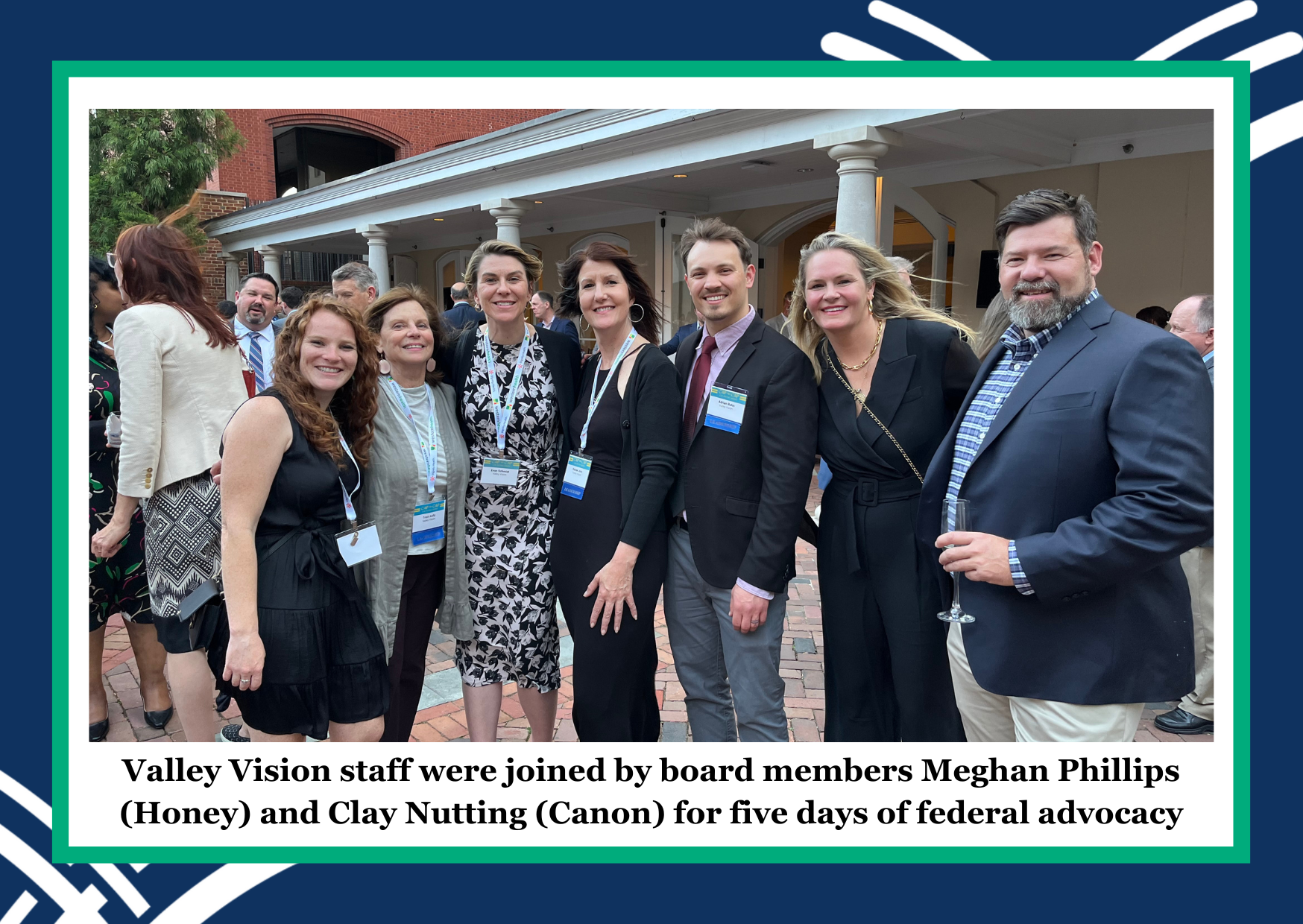
Right now is a critical time to engage with the federal government.
Once-in-a-generation resources are available for the “big play” investments that our region needs to grow and thrive. Valley Vision has a long history of participating in the Sacramento Metro Chamber’s Capitol-to-Capitol program, which serves as our region’s premier federal advocacy opportunity each year. This program provides opportunities to meet with the Sacramento Region’s federal legislators and encourages participants to meet with federal agencies, many of whom oversee competitive funding programs.
This year’s 52nd annual“Cap-to-Cap” was the largest on record, with 425 leaders participating. Valley Vision staff led and supported many of the topic-based teams and, in keeping with tradition, have documented their experiences below.
Clean Air & Climate by Adrian Rehn
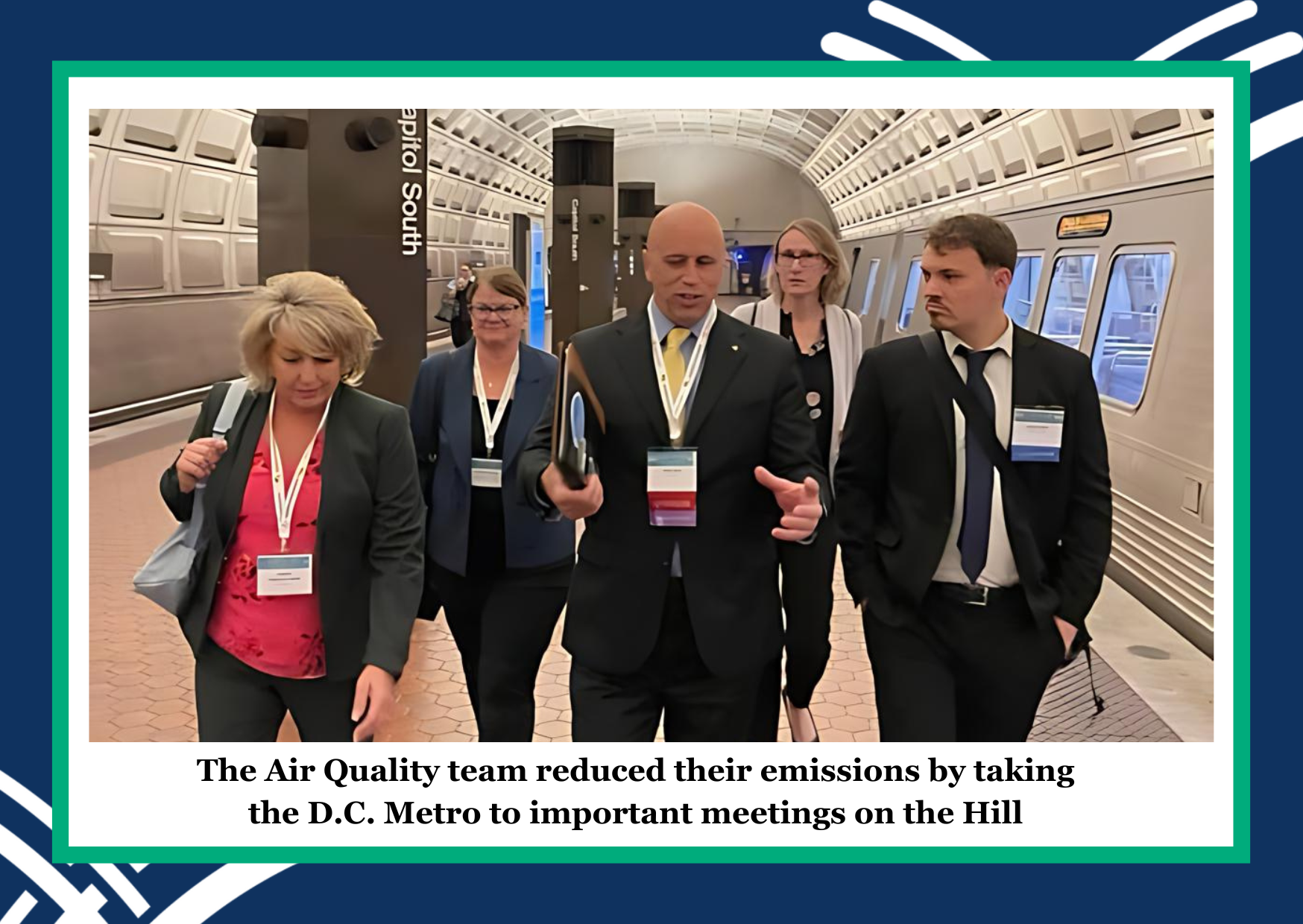
The Cleaner Air Partnership, which Valley Vision staffs, staffs two of the thirteen policy-focused “teams” focused on (1) air quality and (2) wildfire. This year, our teams elevated funding for a comprehensive suite of air quality strategies as part of the Climate Pollution Reduction Grant program, climate projects of regional significance, and technical but extremely important policy fixes like letting air districts “write off” smoke from preventative prescribed fire instead of getting dinged by U.S. EPA. We are in the process of following up on these important “Asks” and look forward to continued engagement throughout the year as we continue to work toward cleaner air for all.
Workforce Development & Education by Renee John
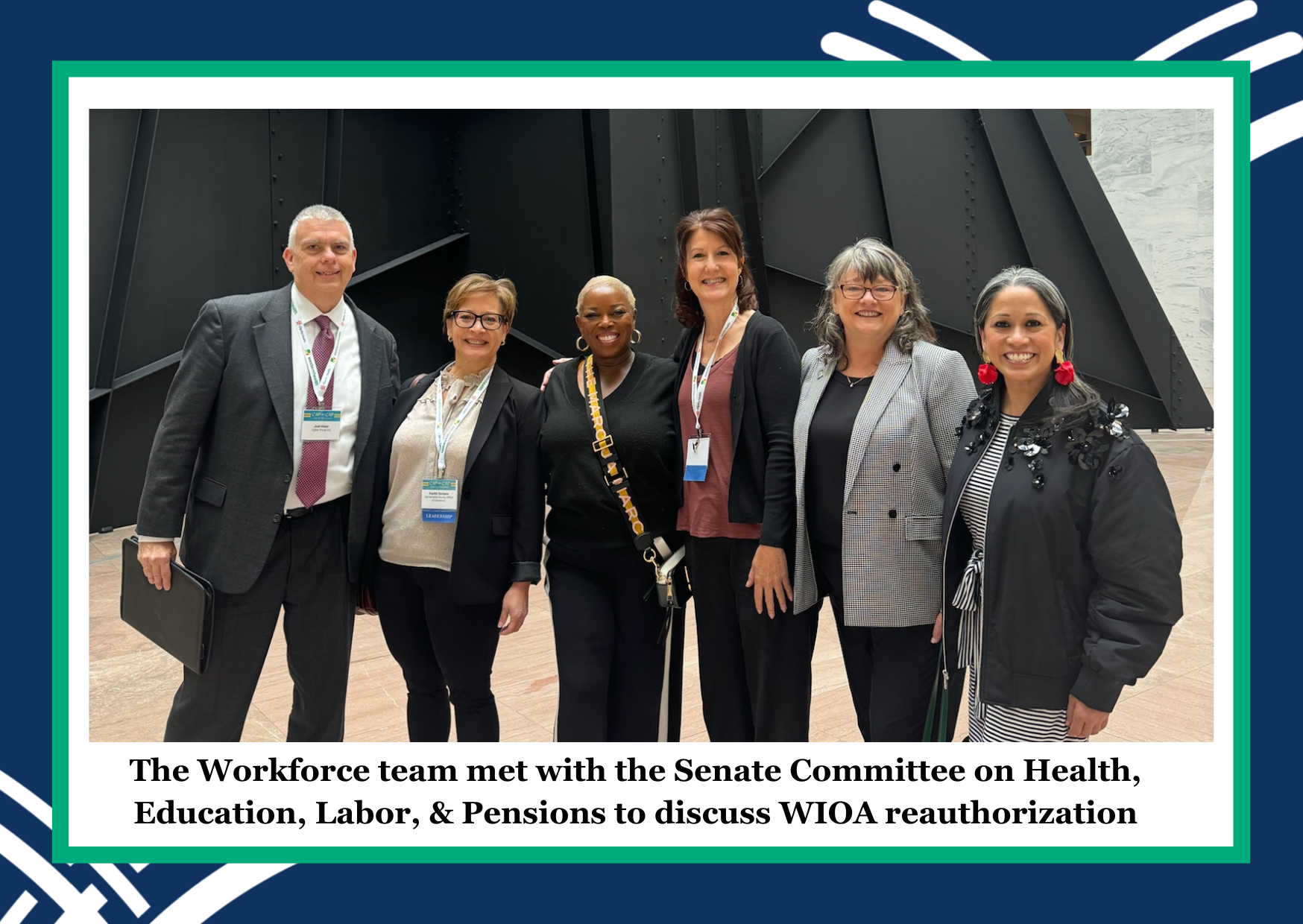
During my third in-person year at Cap to Cap, I co-led the team representing workforce and education. Our team advocated for the reauthorization and modernization of key acts including WIOA, the National Apprenticeship Act (NAA) and the Preparing and Resourcing Our Students and Teachers Act (PROSPECT), as well as expansion of Pell Grant eligibility and Perkins grant funds for vocational and technical education. Our team was co-led by Xanthi Soriano from SCOE and Ejiro Okoro from United Way California Capital Region, and included over 40 individuals from workforce and education institutions including preK-12, higher education, nonprofits, and elected officials.
This year, as in prior years, myself and team members had the opportunity to speak with folks shaping legislation that governs our ability to invest effectively in upskilling our region’s workforce. WIOA has been passed out of the House of Representatives and is currently in the Senate for markup. The Senate HELP Committee is currently creating its own version of the bill. While workforce legislation is generally bipartisan, different opinions on key provisions are common. Our goal was to share stories from the field to illustrate how vital federal funding is to our workforce and education efforts, highlight the key investments California is making, and encourage the federal government to work with haste to streamline and invest effectively in initiatives to ensure our businesses have the talent they need with the ability to pay living wages.
Impacting federal legislation can seem far removed from the daily work we all do. However, my experience has been that folks in Washington D.C. are interested to hear what is working well and what could be improved from partners implementing programs in their cities and regions.
Economic Development by Evan Schmidt
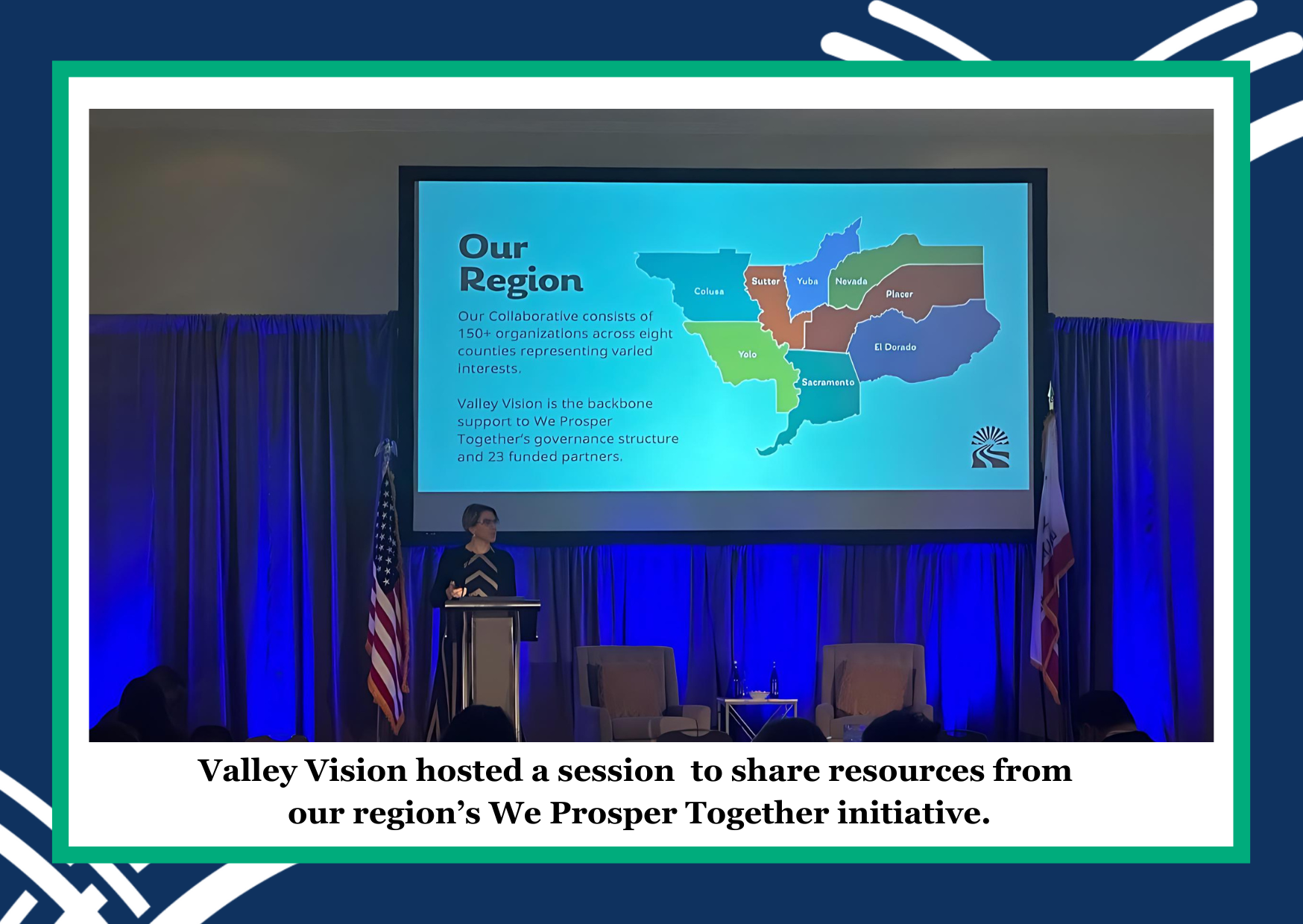
The Economic Development team took the opportunity at Cap-to-Cap to share and advocate for our key regional economic growth priorities and drew connections from the California Jobs First (formerly CERF) regional We Prosper Together initiative. Investing in and advancing the California Mobility Center and clean mobility innovations; advancing job creation and infrastructure around precision manufacturing; supporting our agricultural and life sciences assets including Aggie Square and ag innovation coming out of UC Davis and beyond; and supporting the supply chain and economic activity surrounding our region’s working lands were key priorities carried by the team.
We were able to meet with our regional representatives as well as key federal contacts at the National Science Foundation, Economic Development Administration, Small Business Administration, and US Department of Commerce, CHIPS for America. These meetings create opportunities for our region to identify investment opportunities with key federal contacts, communicate our region’s value proposition and needs, and build cohesion among regional stakeholders.
Valley Vision was also pleased to host a session for all delegates with our partners at the Brookings Institution to share data resources that have been compiled and analyzed for our region in the last nine months as part of the We Prosper Together initiative. Brookings researchers reinforced the importance of our key industry sectors and shared analytics about our region’s economic and innovation landscape. Explore the data and read the Executive Summary here.
Food and Agriculture by Grace Kaufman
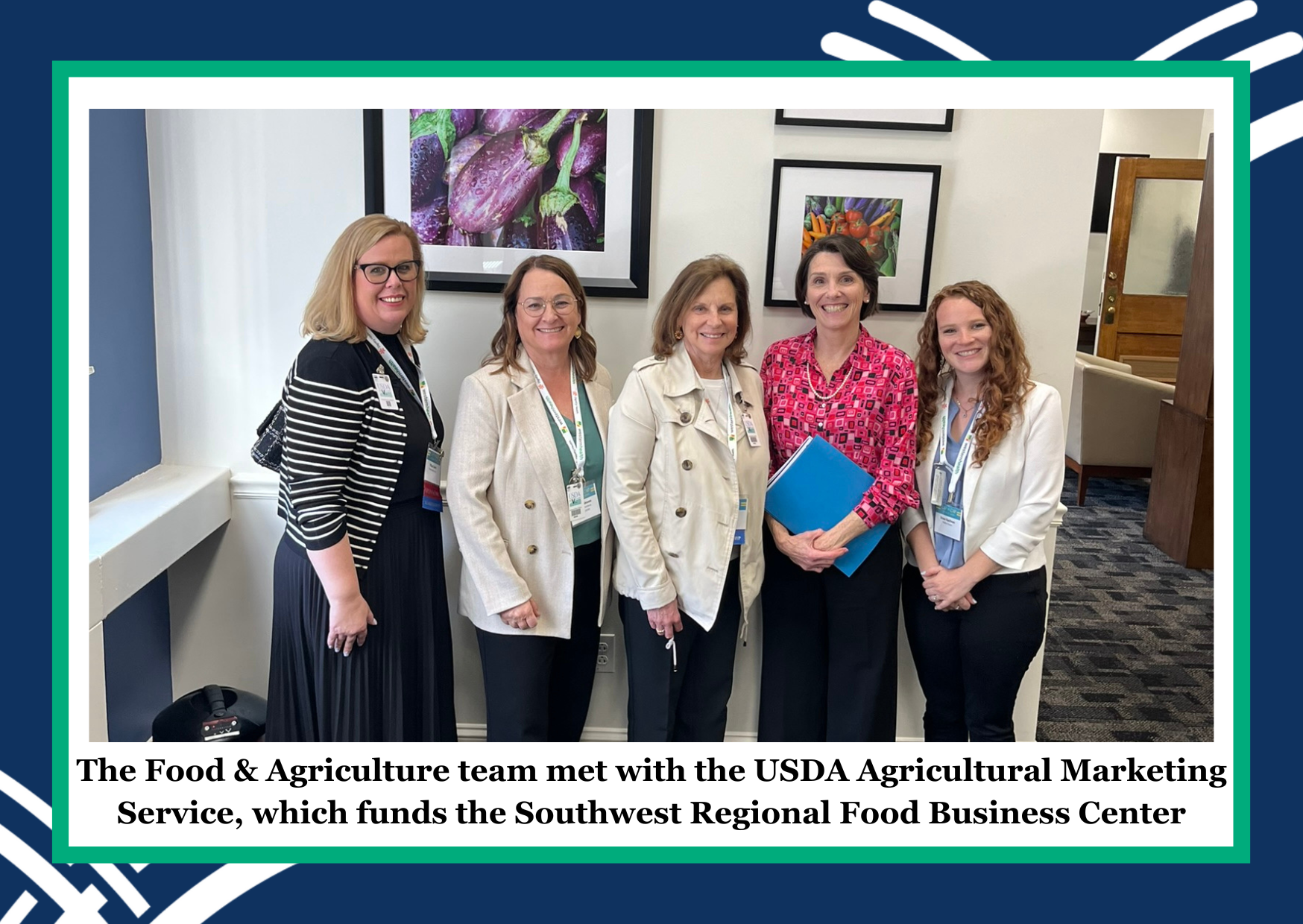
How can we leverage funding across multiple departments in USDA to provide more resources for infrastructure that supports small and mid-size food businesses? How can we improve food and nutrition insecurity while also supporting the region’s local farms and restaurants? Those were some of the questions the food and agriculture team asked our representatives and federal agencies during the 2024 Cap-to-Cap program.
The food and agriculture team met with staff from three separate USDA departments. These meetings helped the team better understand and connect USDA opportunities to support the Sacramento Region’s food and farm businesses. This was particularly helpful for Valley Vision, as we support coordination and communication for the new USDA Southwest Regional Food Business Center, one of a network of 12 Centers across the country that provides resources and technical assistance to underinvested farmers and food producers.
This year was my second year attending the program, and I look forward to attending next year to advocate for the Sacramento Region and the Southwest Regional Food Business Center. In the meantime, Valley Vision will continue to work with partners to build a food and agriculture system that is resilient, innovative, sustainable, and equitable.
Food and Agriculture and Economic Development by Trish Kelly
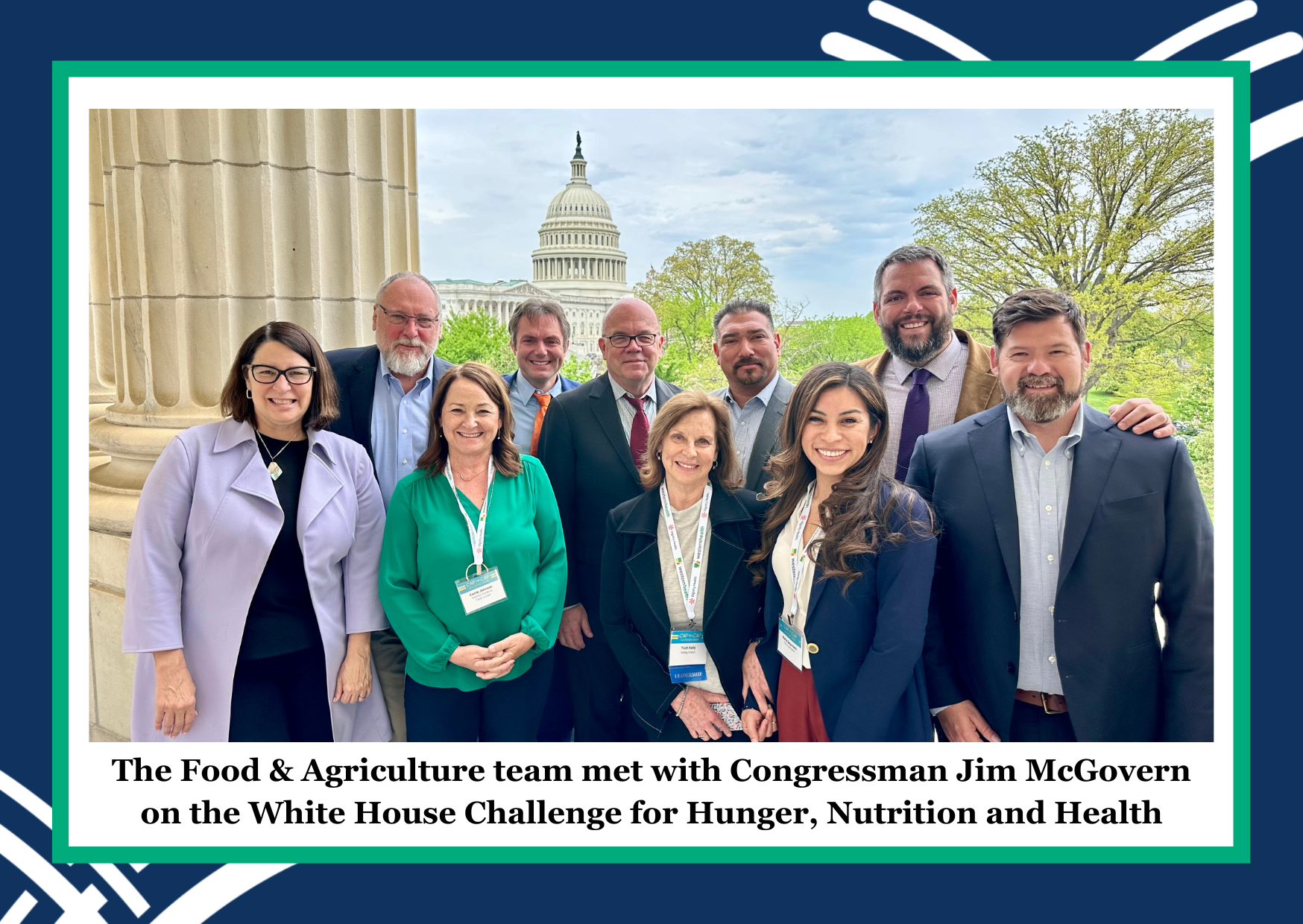
I co-lead the Food and Agriculture team and support the Economic Development team. Our priorities centered on the passage of the 2023 Farm Bill as well as overall food system resiliency. These two areas encompass such important issues as hunger and nutrition security, food is medicine, agricultural viability, institutional procurement (farm to school and farm to hospital), broadband connectivity, and food economy projects. The region is well positioned as an innovation leader in all these areas and we focus on telling our story and raising awareness of the region nationally, as well as on specific asks, such as removing barriers to healthy food access and fully funding the Farm Bill (which is passed every 5 years, but has been rolled over to 2024).
Our team includes a great cross-section of our food and agriculture ecosystem – nonprofits including food banks, farmers, local governments including elected officials (mayors, council members and supervisors), chefs both from restaurants and UC Davis Health, UC Davis main campus, University of California Agriculture and Natural Resources (UC ANR), and businesses.
This is my tenth year participating in Cap-to-Cap and I have seen its strength and impact grow over this time. We’re really built this team from a small and mighty core to a diverse and energized group of leaders, backed up by supporters at home. I look forward to this trip every year as the opportunity to meet with staff and leaders in Congress, including not only our delegation but the staff at key food and ag committees, at the federal agencies, and with organizations such as the American Farm Bureau Federation, national food policy and advocacy organizations and the Brookings Institution.
Two key highlights for me were meetings with Kelliann Blazek, the White House Agriculture and Rural Policy Advisor, and Congressman Jim McGovern, on the White House Challenge for Hunger, Nutrition and Health, and food is medicine legislation. They are inspiring leaders working to end hunger and improve health. But overall, our meetings with our local congressional leaders, USDA, EDA and SBA (the latter two through economic development) were so valuable in learning about new resources, better understanding the opportunities and challenges of the current legislative term, and gaining support for the region.
We’re proud to be part of the largest delegation that comes to DC on a community-focused mission. Since our trip, we have already had a follow-up on a few key priorities, and we feel our team has returned strengthened and committed to carrying the good work forward for the region. We appreciate the opportunity through Cap-to-Cap to engage with local leaders and champions in DC, which carries over into our work at home. We encourage anyone who wants to engage in these issues to stay in touch!
Navigating the Waves: Insights from the Water Careers Event

The Energy, Construction, and Utilities (ECU) Advisory event offered a view of water-related career opportunities within the region, delivering valuable perspectives for program development in the field. The event highlighted the opportunities and the challenges of an imminent skill shortage.
Ramzi Mahmood, Director of the Office of Water Programs (OWP) at Sacramento State, and Patrice McElroy, Deputy Administrative Officer from Valley Water, were keynote speakers and shared impactful presentations on the landscape of workforce development in the region, the Labor Market Data presented by the Center of Excellence showed signs of growth, with estimates of an increase from 7,150 positions in 2022 to an anticipated 8,003 by 2027, marking a notable 12% expansion in the region.
However, amidst this positive outlook of job growth, tackling the worker shortage was a predominant theme. Mahmood spoke on the forthcoming wave of retirements over the next 5-10 years, compounded by a nationwide hiring squeeze, presenting challenges in filling critical positions. The keynote stressed the inadequacy of relying solely on chance to attract students to water-related careers. Instead, Mahmood advocated for a comprehensive strategy encompassing early education, specialized training programs, hands-on experiences, recognized certifications, and pathways to successful career attainment. The employer panel echoed similar sentiments. Specifically, Samantha Blackwood from the Department of Water Resources (DWR) explained that one in ten DWR employees are currently eligible for retirement, and in five years the numbers will jump to 20 percent, or one in five, and in 10 years roughly one of three DWR employees are eligible for retirement.
In response to this anticipated shortage, panelists advocated for strategic investments in internships and grant programs. Additionally, training institutions and employer agencies can collaborate to provide practical experience and financial support to prospective employment candidates, laying the groundwork for a skilled future workforce.
As the dynamics of the regional water job market evolve, a focus on planning, education, and investment becomes imperative. Insights gathered from events like this advisory serve as an opportunity to share strategies and networks to navigate this shifting industry landscape. Additional information including the full event recording and presentation materials can be found here.
Building the Full Stack: Stackable Credentials in ICT

Valley Vision held a regional Information and Communication Technologies careers advisory on October 12. The event showcased strong demand across all occupations and the need for a collaborative and concerted effort to address the expansive gap. According to data shared by the Center of Excellence for Labor Market Research, the ICT industry is set to have a projected 6% job growth over the next five years, accounting for 2,741 annual job openings in the Greater Sacramento six county region. With the median annual wage across the industry at $102,497, it presents a significant opportunity to align community members and priority populations to these lucrative pathways.
Diversity and inclusion were a hallmark of the event. With a current significant gap of 1,371 skilled workers required to meet the demand for ICT careers, the data from Center of Excellence illustrated an underrepresentation of significant portions of our populace. For instance, despite constituting 28% of the total workforce in the Greater Sacramento region, Hispanics and Latinos account for only 15% of the ICT workforce. Moreover, the disparity is pronounced in gender representation, with 71% of ICT workers identifying as male. This significant underrepresentation highlights an untapped potential within communities. By actively engaging and recruiting from underrepresented groups, the industry can not only create a more diverse and inclusive workforce but also benefit from a broader talent pool that better reflects the overall demographics of the region.
Employer representatives shared how ICT positions have become essential in a wide range of companies. The employer panel included representatives from Placer County, Microsoft Philanthropies, City of Roseville, and Swinerton, a national construction company. The discussion covered several key themes, including the most sought-after skills, the importance of recruiting from underrepresented communities, and the goal of providing more internships. In sharing insights about their respective organizations, the panelists showcased their commitment to fostering inclusivity and expanding opportunities for individuals by working more closely with the community colleges.
One specific example showcased specific alignment between a college and employer partner. Swinerton gave details on a partnership with Sierra Community College that demonstrated collaboration between industry and CTE programs. Sierra College created a series of courses matched to the ICT needs of Swinerton construction help desk positions. The college also worked with Swinerton to update job descriptions with matching course numbers in their listed qualifications. This alignment allows students to not only have the opportunity to participate in an internship but also makes explicit the relevance of their education to immediate employment.
The advisory showcased various pathways available for individuals to develop entry-level, ICT-related skills. The Sacramento Public Library shared information on free Adult Education Career Development classes in basic digital literacy and career readiness, including free certifications from Coursera and Gale, in cyber security and data analysis. Byte Back, a community based organization whose mission is to close the digital divide by providing under-resourced communities an equitable pathway into the digital economy, detailed their free 360 Digital Navigators program designed to help people gain technical digital skills. Their community-2-community approach supports digital navigators with the skills, resources, and knowledge necessary to assist fellow community members with gaining internet access and navigating everyday digital tasks imperative to work, health, education, and life. These two programs are examples of accessible building blocks in under-resourced communities that can be essential components of developing inclusive ICT career pathways.
All participants emphasized the need for continuous education and training in the field and illustrated how stackable skills and certifications, from community organizations to community colleges and industry partners, can collaborate to meet the current and projected demand. Additionally, continuous learning enables workers to stay updated with the necessary skills to thrive in an increasingly technology-driven workplace. Employer and workforce system partners working in collaboration can design effective pathways from neighborhoods to these promising careers.
The Capital Region’s Workforce—Ready to Evolve
The Livability Poll is a broad-based quality-of-life survey developed by Valley Vision and CapRadio in collaboration with the Institute for Social Research at Sacramento State University. Valley Vision conducted the poll to assess Sacramento residents’ experiences with issues related to housing, access to services, job and career satisfaction, safety and belonging, and residents’ perceptions of the Sacramento Region. Among many topics, the Poll results provide insight into how community residents view their employability.
The Poll was in the field from mid-June to mid-July of 2022. It is demographically representative of the Capital Region, encompassing Sacramento, El Dorado, Placer, Sutter, Yolo, and Yuba counties, and has a margin of error of plus or minus 2.3 percent
Overall satisfaction with employment is high, but a stark contrast can be seen when broken down into categories like race. The most cited reasons for dissatisfaction were low wages; not enough opportunities for promotion; and poor workplace culture. However, feelings of optimism in younger people in the workforce when it comes to employability have risen from previous polls that Valley Vision fielded during the height of the pandemic. As the future of workers continues to change, it was found that more than two-thirds of residents are interested in learning new skills or improving their skills through education and training.
However, the delivery method is key to ensuring residents can access education and training programs. Residents expressed preferences for:
- Programs that last a year or less (72 percent),
- Hybrid (53 percent) or remote (57 percent) programs, and
- Flexible or weekend hours (62 percent)
In order for our region to keep pace with changing industry needs, our communities need flexible and accessible training programs to upskill and increase their economic mobility actively.
While this data confirms the need for equitable career advancement opportunities, the numbers also paint a picture of what is possible. The Capital Region’s workforce is ready to evolve, and our region’s workforce stakeholders have an opportunity to deliver innovative, accessible training solutions to meet their needs. The full 2022 Livability Poll Report can be accessed here.
To keep up with Valley Vision’s work to advance a future-ready workforce in the Sacramento region, subscribe to our 21st Century Workforce email newsletter!
Angelina Olweny is a Valley Vision Project Associate supporting initiatives within the 21st Century Workforce impact area.
Gustavo Garcia is a Valley Vision Project Associate supporting initiatives within the 21st Century Workforce impact area.
Danielle Susa is a Valley Vision Project Associate supporting initiatives within the 21st Century Workforce impact area.
State Workforce Leaders Moving Forward Together
Valley Vision’s Renee John, Director of Workforce Development, recently attended the California Workforce Association’s annual Meeting of the Minds Conference themed Courageous Progress. A central topic was the Governor’s priority on apprenticeships as one of three key workforce strategies to address California’s wide scale income inequality challenges. A five-point action plan was recently released from the Labor and Workforce Development Agency and the Department of Industrial Relations Department of Apprenticeship Standards outlining a strategy to expand apprenticeship in California to meet Governor Newsom’s goal of serving 500,000 apprentices by 2029.
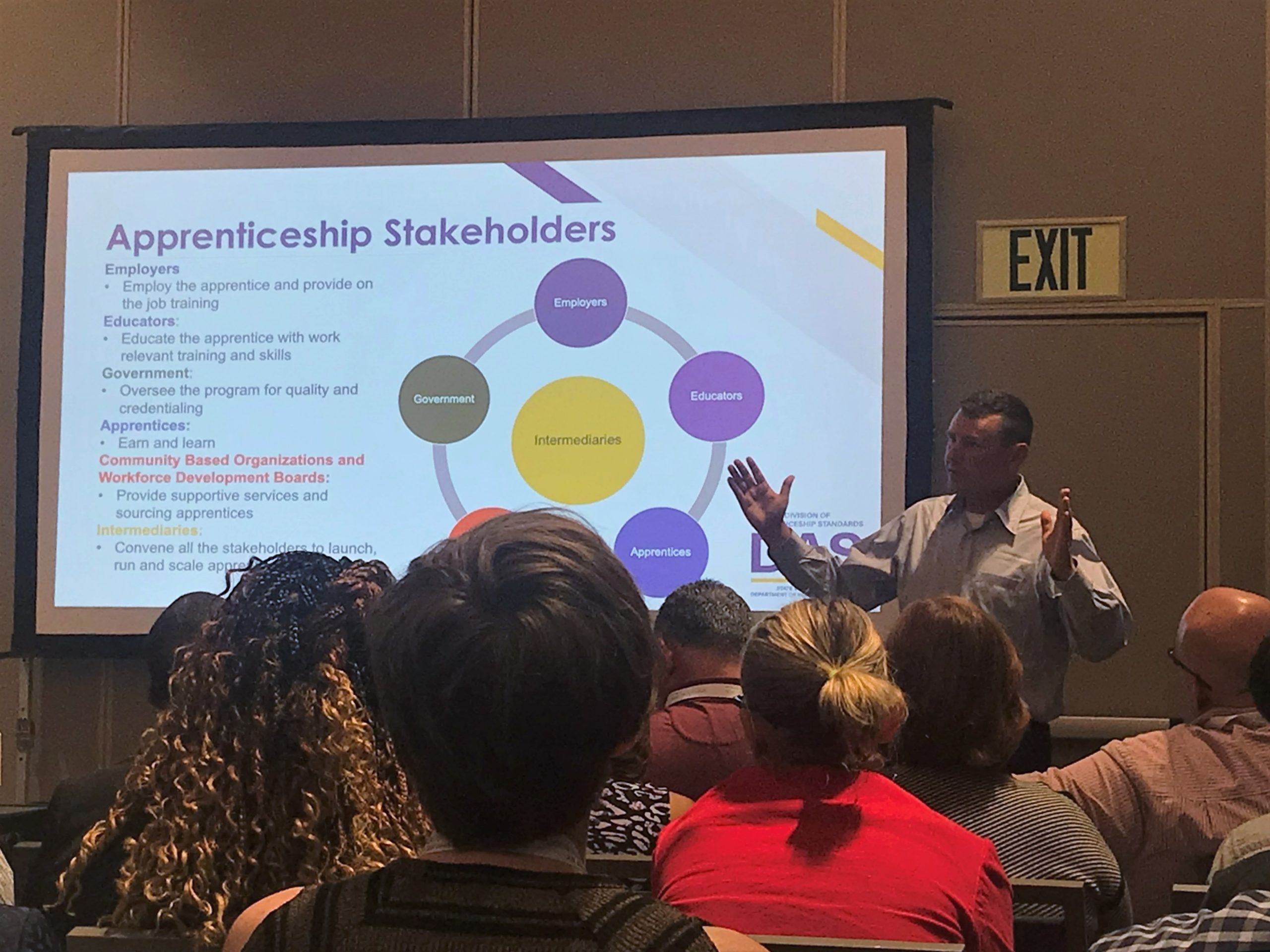
The conference, held in Monterey, featured speakers from across the state including: Tim Rainey, Executive Director California Workforce Development Board; Brent Parton, Acting Assistant Secretary DOLETA; and Eric Rood, Chief Division of Apprenticeship Standards at California Department of Industrial Relations. Informative sessions addressed topics including developing high quality youth and adult apprenticeships, digital upskilling innovations, service delivery models to serve the priority populations including re-entry and individuals with disabilities, and sector specific workforce pipeline initiatives. The importance of strategically aligning efforts between workforce stakeholders was a central theme. Each session featured inventive collaborations between K-12, adult education, community colleges, economic development, community based organizations, and others.
As the workforce intermediary for the Greater Sacramento Capital Region, Valley Vision spends significant resources on convening and alignment, connecting partners in our ecosystem together to develop solutions and function as a cohesive unit in service to their stakeholders. We assist cities, jurisdictions and partners with developing strategies to meet their economic and labor goals. We are a trusted source for quality research on workforce issues and trends to inform on changing market dynamics. And, we continually work to amplify voices and strategies to connect equity to economic prosperity to create a vibrant and prosperous economy for all.
For the more information on Valley Vision’s 21st Century Workforce impact area connect to our website and subscribe to our 21st Century Workforce email newsletter!
Valley Vision’s employer and industry advisories are funded by Los Rios Community College District with Strong Workforce Program funds. Additionally, the Capital Region’s four workforce boards co-sponsor the advisories; SETA/Sacramento Works, Golden Sierra JTA, YoloWorks, and North Central Counties Consortium.
Renee John is the Director of Workforce Development managing initiatives within the 21st Century Workforce impact area.
Forestry Management Careers: A Critical Need
On April 28, Valley Vision hosted a virtual Forestry Management Regional Advisory to bring stakeholders and industry partners together to discuss the field’s current state, future projections, and areas of growth. Critical land management challenges such as wildfires, droughts, and the impact of invasive species contribute to the high demand for forestry management job applicants. However, labor market data and research detail a prominent gap between this need and the availability of candidates in the field.

This event featured labor market projections from Melissa Kovacs, Senior Project Analyst at the Center of Economic Development, CSU Chico, and Ebony Benzing, Research Manager at the North/Far North Centers of Excellence, and an industry panel that included:
- Ann Anderson, Beale Mountain Forestry, Owner & Forester
- Jeremy Dorsey, U.S. Forest Service, Hume Lake Ranger District & Sequoia National Forest, District Ranger
- John McCarthy, CAL FIRE, Forester & Wood Products/Bioenergy Program Administrator
- Tony Ortiz, Mountain Enterprises, Field Safety Specialist
- Craig Ostergaard, Sierra Pacific Industries, South Sierra Reforestation Manager
At the beginning of the event, Kovacs presented findings from the 2021 Forest Sector Workforce Needs Survey created in partnership with the Statewide Wildfire and Forest Resiliency Task Force. This survey yielded 113 responses from forestry management employers across the state and sought to identify key challenges and needs within the industry. The research revealed a sizable gap in the forestry industry’s workforce with the majority of respondents indicating their organization is currently hiring for 1-5 open positions with the majority looking to hire either immediately or within the next 12 months. Another important result was the indication of three major obstacles to filling these positions; high cost of living (45.59%), a small pool of candidates in the area (24.56%), and lack of available housing (12.81%).
Benzing provided regional labor market information, demonstrating forestry management jobs are expected to grow by an average of 6% by 2025 in the Greater Sacramento region. The strongest occupational demand is in professional positions which include environmental scientists, soil & plant scientists, and foresters. Management positions are projected to have the highest percentage growth, with the second-largest increase slated to come from specialty positions (fallers, log graders/scalers, surveyors, tree trimmers, and mapping technicians).
Panelists encouraged students and educators to push for early exposure to forestry management careers and real-world, hands-on experience. Paid internships are a valuable way for prospective applicants to gain an understanding of the demands and nature of these jobs. Although these positions are generally during the summer months, panelists indicated winter is the best time to begin the internship and job search process. Anderson of Beale Mountain Forestry mentioned job shadowing as an alternative to internships, as they are a quicker, less-demanding method to show the daily responsibilities and expectations of someone who works in the industry.
Panelists agreed that interpersonal skills are of great importance and demand in the forest industry. Communication, time management, organization, and teamwork are integral skills across all occupations creating an opportunity for forestry management education programs to focus on expanding soft skill development. In addition to strengthening these necessary skills, Steven Casperite, Assistant Principal at the Placer School for Adults, discussed a pilot program developed in partnership with Mountain Enterprises to expand the talent pipeline by offering contextualized English Language education concurrent with on-the-job forestry management training to serve immigrants and refugees. Casperite also commented that the opportunity to extend training opportunities to incarcerated individuals prior to release can also funnel more candidates into the industry. As Casperite said, “There are a lot of opportunities and employees out there that we can be putting to work—that want to work—but we’ve got to remove the barriers.”
Valley Vision’s employer and industry advisories are funded by Los Rios Community College District with Strong Workforce Program funds. Additionally, the Capital Region’s four workforce boards co-sponsor the advisories; SETA/Sacramento Works, Golden Sierra JTA, YoloWorks, and North Central Counties Consortium.
To keep up with Valley Vision’s work to advance a future-ready workforce in the Sacramento region, subscribe to our 21st Century Workforce email newsletter!
Danielle Susa is a Valley Vision Project Associate supporting initiatives within the 21st Century Workforce impact area.
Renee John is the Director of Workforce Development managing initiatives within the 21st Century Workforce impact area.
Leading with Compassion: The Future of Hospitality Careers
On April 22, Valley Vision hosted a virtual regional advisory centered on the adaptations of the Hospitality, Culinary, and Tourism industry through the pandemic. While the sector continues to represent employment below pre-pandemic employment levels, the Greater Sacramento region has recovered 40% of jobs originally lost in this sector. Nationally, wages have increased by almost $3.00 per hour to an average of $19.68.

The event featured keynote speaker Marc Sapoznik, President and CEO of Rancho Cordova Travel & Tourism, labor market information from Aaron Wilcher, Research Director of the Center of Excellence, and an industry panel including:
- Shelly Moranville, General Manager, Residence Inn, Marriott
- Jonathan Modrow, Owner, Bottle & Barlow
- Brittany Claypool, Brand Strategist, Oak Park Brewing
- Andrew Moret, Director of Culinary, Oakmont Management Group
- Marc Sapoznik, President and CEO, Rancho Cordova Travel & Tourism
During the event, panelists described changes and innovations within their companies including moving to fast-casual service with to-go options, producing canned beverages, advancing the adoption of technology, partnering to recruit for talent shortages, and turning a portion of their establishment into community rental space. As Shelly Moranville from Residence Inn, Marriott put it, “We’ve changed the way we do everything.”
“We’ve changed the way we do everything.”
Shelly Moranville
The labor market information presented highlighted a need to fill management positions including General and Operations Managers, Food Service Managers, Personal Service Managers, Entertainment and Recreation Managers, Chefs, and Head Cooks. These positions also offer the highest earnings potential within the industry. The panel agreed on the need for training for management positions highlighting the burnout of their leadership teams from the toll of the pandemic.
Several panelists acknowledged investing more in their current workforce than in the past, including establishing “paths to success” for entry-level employees to gain the skills and experience necessary to prepare them for higher roles. Andrew Moret of Oakmont Management Group discussed their Executive Chef Training Program in development as an example of this upward mobility framework. The panel agreed that learning the career goals of individual team members and helping them achieve them was a best practice. This was just one example of a change to a more employee-centered culture including increased flexibility and accommodation of individual employee needs and schedules. Employers reported altering the availability requirements for existing workers and incoming hires to improve employee retention. As Ms. Moranville stated, “[We] have to be much more flexible to the needs of the associates, and I don’t think that’s a bad thing. As employers, [the pandemic] has forced us to shift and be more understanding of what’s going on in someone’s life.”
The panel agreed the need for high-quality soft skills or essential skills was desperately needed in employment candidates including communication, teamwork, leadership/initiative, cultural and self-awareness, and creativity/adaptability. Jonathan Modrow of Bottle & Barlow stressed the need for an “instinct for care and collaboration”. Mr. Moret closed us with critical words for today’s culture stating the need to lead with “compassion for guests, each other, and yourself” is greatly needed in today’s hospitality workforce.
Valley Vision’s employer and industry advisories are funded by Los Rios Community College District with Strong Workforce Program funds. Additionally, the Capital Region’s four workforce boards co-sponsor the advisories; SETA/Sacramento Works, Golden Sierra JTA, YoloWorks, and North Central Counties Consortium.
To keep up with Valley Vision’s work to advance a future-ready workforce in the Sacramento region, subscribe to our 21st Century Workforce email newsletter!
Danielle Susa is a Valley Vision Project Associate supporting initiatives within the 21st Century Workforce impact area.
Renee John is the Director of Workforce Development managing initiatives within the 21st Century Workforce impact area.
Highlighting Training Needs in Cybersecurity

Valley Vision serves a unique role as the workforce intermediary in the Capital Region’s training and development ecosystem. In this role, we work closely with the community colleges, workforce boards, community-based organizations, employers, industry partners, and local jurisdictions to improve our region’s responsiveness to the needs of both industry and the community. To that end, Valley Vision produces employer and industry advisories in occupational areas of growth and interest to inform education and training partners to address and respond to these needs to support our overall economy.
On March 31st, Valley Vision hosted an advisory on the growing demand for Cybersecurity occupations. The advisory included a keynote presentation by Nathaniel Le of the Federal Bureau of Investigation (FBI) and labor market information including job posting and skills analysis by Ebony Benzing, Research Manager of the Center of Excellence, as well as an industry panel discussion with the following representatives:
- Tania Webb, Managing Director of Deloitte
- Benjamin Troglia, Associate Director of Accenture
- Andrew Maroun, Director of Information Security of Golden 1 Credit Union
- David Bitter, Cybersecurity Manager of SMUD
During the advisory, panelists described a need for both generalists and specialists to meet their staffing needs. While specific technical skills are needed, the highest demand traits these employers revealed were a passion for the work and interpersonal skills, including written and verbal communication, to work well within teams and with external customers. Webb indicated understanding the “why” of the services employees are providing is essential and pre-eminent to thinking through how the technology solution helps meet that need, while Bitter indicated applicants who demonstrate an interest in the field beyond classwork, through clubs or competitions, are highly valued. Additionally, he noted the challenge for educators to keep up with the training needs of the industry due to technology evolving exponentially. He indicated and other panelists agreed, that there is more tendency to recruit generalists who can learn specialties on the job. “I don’t think it’s realistic to expect these students coming out of educational institutions to have that (specific) knowledge,” Bitter said.
While panelists indicated recruiting individuals with a Bachelor’s Degree (or higher) was common, most stated they are open to candidates who can demonstrate the experience, skills, and knowledge without a degree.
Panelists were asked about specific technical skills, degrees, and certifications to obtain entry-level employment in the field. While panelists indicated recruiting individuals with a Bachelor’s Degree (or higher) was common, most stated they are open to candidates who can demonstrate the experience, skills, and knowledge without a degree. Certifications were indicated as one way to differentiate while seeking employment, although practical real-world experience had as high or higher of a value. Specific certifications in demand include SAMs, CISP, and CompTIA Security+, which can elevate one candidate over another and demonstrate the candidate’s initiative to continue learning in their field. Specific technical skills in demand included Linux, Python, and Network Security.
When asked what advice would the panelists give to individuals trying to break into the Cyber Security field, networking, getting as much practical experience as possible, and staying up on the latest news in the security field were indicated as key. Maroun noted a particular challenge is the lack of diverse candidates entering the field which among other challenges limits the group’s creativity diverse backgrounds bring in developing solutions.
Join us for two additional upcoming advisories on the changing needs of Hospitality, Culinary, and Tourism on April 22nd and the expanding needs for Forestry Management Occupations on April 28th. Valley Vision’s full resource industry of advisories is available here.
Valley Vision’s employer and industry advisories are funded by Los Rios Community College District with Strong Workforce Program funds. Additionally, the Capital Region’s four workforce boards co-sponsor the advisories; SETA/Sacramento Works, Golden Sierra JTA, YoloWorks, and North Central Counties Consortium.
To keep up with Valley Vision’s work to advance a future-ready workforce in the Sacramento region, subscribe to our 21st Century Workforce email newsletter!
Nghia Nguyen is a Valley Vision Project Associate supporting initiatives within the 21st Century Workforce impact area.
Renee John is a Valley Vision Project Leader managing initiatives within the 21st Century Workforce impact area.
Digital Inclusion Coalition Expands with New Platform
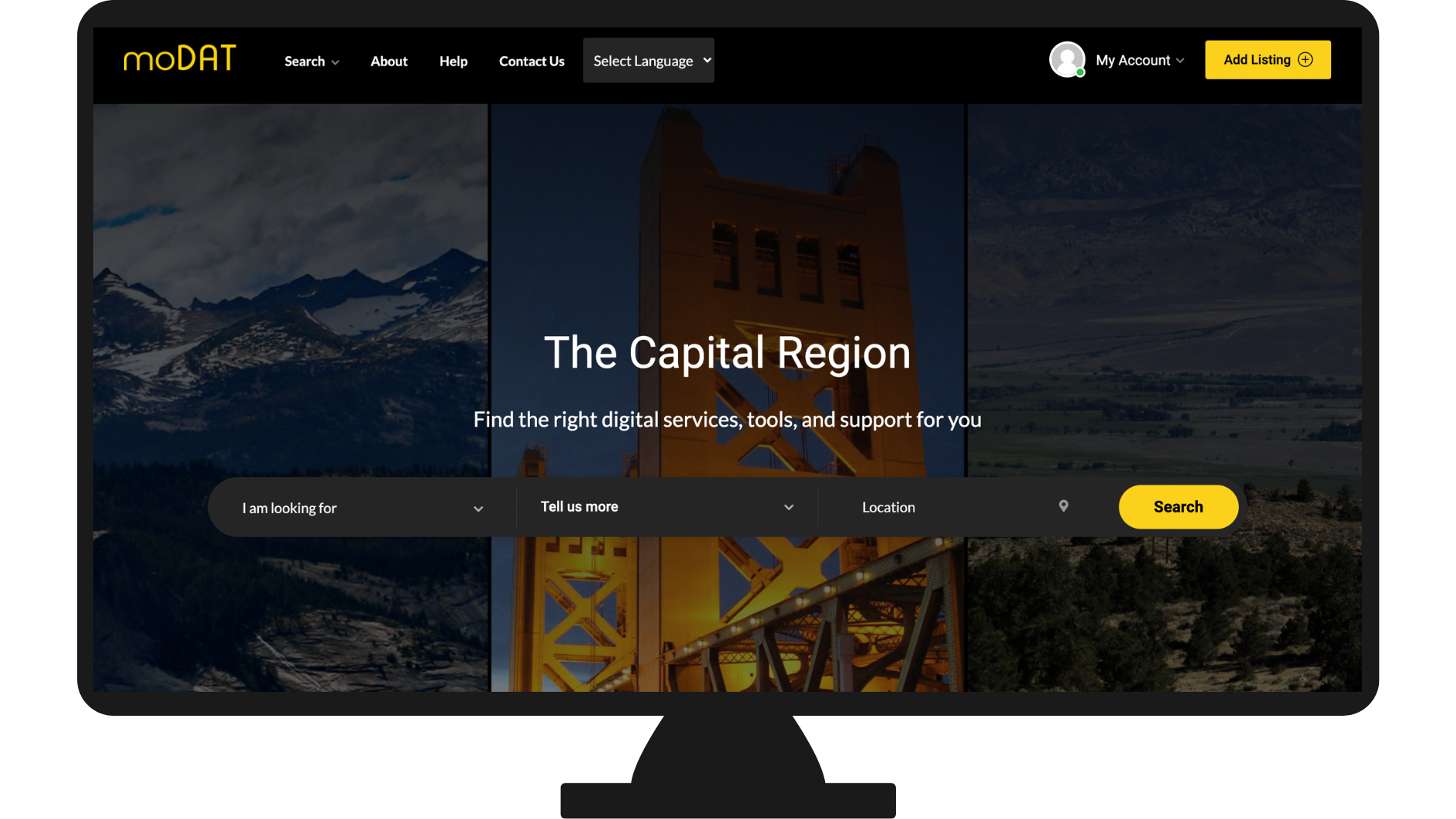
The last two years have proven the significance of digital inclusion to accessing opportunity and economic prosperity. Our nation is experiencing unprecedented investment, including the Affordable Connectivity Program through the Federal Communications Commission (FCC) – a $14.2 billion piece of the Infrastructure Investment and Jobs act, and the biggest investment in broadband this country has ever seen. The Greater Sacramento region is well poised to garner and maximize investments in digital inclusion due in no small part to the dedicated contributions of the steering committee, working groups, and members of the Sacramento Coalition for Digital Inclusion (Coalition).
This effort started in the fall of 2018, inspired by a Brookings Institution report on the strengths and weaknesses of the Sacramento Capital region, and culminated in the formation of the Coalition. Over the years, the work of the Coalition has brought together partnerships, thought leaders, and collaborative investment to address the digital inclusion needs of our region especially during the heightened needs of the pandemic.
A Year of Impact
In the last year, the Coalition has hosted eight full Coalition meetings and over 25 working group meetings in three key areas; Broadband Access & Adoption, Hardware Devices, and Digital Literacy/Digital Skills to build a framework and key strategies including:
- Renaming, redesigning and taking over management of the Coalition website to provide easy access to resources and information
- Operationalizing a digital inclusion portal to provide easy access to free resources for community members and the organizations supporting them
New Name & Expanded Region
The Coalition recently changed its name to the Capital Region Coalition for Digital Inclusion, reflecting an expanded service area and regional approach to creating more opportunities for digital equity. This name change represents the expansion to serve a 9 county region supported by investment from the Capital Region’s four workforce boards, SMUD, AT & T and Union Bank, and magnifies opportunities to address both rural and urban digital equity barriers, and convene organizations from across the region to better inform, connect, and partner to promote community success.
New Digital Inclusion Portal Serving Nine Counties
Valley Vision is pleased to partner with mohuman, a non-profit connecting low-income communities with digital resources, to create the Capital Region Digital Inclusion Portal. Through this partnership, a streamlined platform has been created for the Capital Region, allowing community members and those serving them to easily search for resources – including free and low cost computers, internet services, digital skill building tools and training. Among other resources, the Digital Inclusion Portal connects individuals with training on Microsoft Office and Google Suite, as well as career search skills and more! The platform also allows organizations with digital inclusion resources to add their information to the Portal (after a review process) and claim their listings to provide additional description and detail.
Nishal Mohan, Founder of mohuman, describes the work of the Coalition and the impact of the Portal: “The Capital Region and their digital inclusion coalition have been doing a fantastic job of regional coordination to serve digitally un and underserved individuals and families. Now with a personalized and easy to use portal, all of their free or low-cost digital inclusion services and resources are available to the public in an easy to use, accessible, expandable, and sustainable platform so that more people can move towards equity faster, more effectively, and at scale. Congratulations to Valley Vision and partners on bringing a powerful tool with the people for the people of the Capital Region!”
The Coalition’s goal is for the Portal to serve as a centralized source for community members and organizations to find and upload resources for computing devices, internet connectivity, and digital skill building. We need your assistance to create an expansive and thorough network of listings and are calling digital inclusion advocates to aid us in the following ways:
- Share the portal with community members and organizations to utilize for easy access to digital resources
- Add listings through the portal or email nghia.nguyen@valleyvision.org with information on digital inclusion organizations, programs, or online services that need to be included
- If you work at or manage an organization that provides digital inclusion resources, claim your listing, and make it your own!
With your help and assistance, we will continue the momentum to improve digital inclusion for our Capital Region’s current and future digital citizens. To keep up with Valley Vision’s work to advance a future-ready workforce in the Sacramento region, subscribe to our 21st Century Workforce email newsletter!
Caitlin Blockus is a Valley Vision Project Manager supporting initiatives within the 21st Century Workforce impact area.
Yolo County’s YoloWorks! Launches Virtual Employment Center

Job attainment and security are more important than ever, but unpredictable COVID-19 regulations and a turbulent economy have proved it difficult for applicants to access the employment specialists and career services they need. Prior to the pandemic, YoloWorks!, under the Yolo County Health and Human Services Agency, was able to offer in-person career center support and counseling to Yolo County residents from its local offices. However, without a uniform method of providing real-time employment support virtually, the employment center needed to pivot to maintain the full extent of its workforce services.
To address this challenge, YoloWorks! Program Coordinator Erica Johnson developed and aided in the launch of the employment center’s first virtual career center platform. The Virtual Employment Center went live on November 16, enabling Yolo County residents to virtually receive career and vocational training services from employment specialists and case managers.
Making Career Help Available & Accessible
Open 8:00 AM – 4:00 PM Monday through Friday, the Virtual Employment Center (VEC) opens up a myriad of new connections between job seekers and employers. Offering these essential services virtually eliminates a multitude of barriers for new entries to the workforce, including maintaining personal health, reducing travel costs, and more. Training opportunities and the location of available jobs are just two examples of the many services offered by the VEC.
“This is exactly the type of support we want to provide the people of Yolo County.”
Erica Johnson, Yoloworks! Program Coordinator
“Supporting the needs of job seekers with our intelligent chatbot has revolutionized how citizens discover jobs in Yolo County,” said Erica Johnson, YoloWorks! Program Coordinator. “Job seekers can now schedule time with YoloWorks! employment specialists to locate relevant work anytime, anywhere, and have common questions answered quickly in their native language. This is exactly the type of support we want to provide the people of Yolo County.”
Digital Inclusion and the Community
The VEC is a platform that requires internet connectivity to fully utilize. Thus, this calls for adequate infrastructure in the community it serves. YoloWorks! has partnered with Google to provide the “Loan to Own” Chromebook Program for those who might not have access to the devices they need to be successful in this era of virtual integration. Successful completion of this program allows participants to permanently keep their Chromebooks, providing them with a computing device and the ability to earn a work-skills online certificate with digital badging. As of December of 2021, 180 of 250 Chromebooks have been distributed to Yolo County residents. 35 Yolo County residents have completed the program and now own these devices. And to ensure that the platform is accessible to as many communities as possible, Yolo County job seekers can utilize the portal’s chatbox in the region’s three most common languages—English, Spanish and Russian.
This partnership has also granted Yolo County’s YoloWorks! with 500 Google Career Certificates, which are available to Yolo County residents to apply for and receive for free. These certificates include credentials in areas like IT, Project Management, User Experience Design, and Data Analytics. They also provide interested participants with valuable skills such as interviewing tips and connections to 140+ companies that are a part of an employer consortium consisting of nationally-recognized organizations who are hiring for entry-level talent.
From Tragedy Comes Opportunity
With the rise of online outreach and virtual events comes a unique need for collaboration between employers and communities. The VEC constantly works with community partners to ensure that job opportunities are being announced with ample time for applicants to gain access to workstations or smartphones. Additionally, the portal itself promotes ease of access by giving patrons the ability to attach necessary documents (resumes, applications, etc.) and syncing with the account’s Google Calendar. From supplying required technology to providing a user-friendly interface, the VEC is already making waves in terms of reaching the people who would benefit the most from its services.
“The pandemic really shifted the way in which we think, work, and live,” Johnson said. “We wanted to put a service out there for folks that is always available, whether or not they want to come in person.”
To keep up with Valley Vision’s work to advance a future-ready workforce in the Sacramento region, subscribe to our 21st Century Workforce email newsletter!
Danielle Susa is a Valley Vision Project Associate supporting initiatives within the 21st Century Workforce impact area.
Renee John is a Valley Vision Project Leader managing initiatives within the 21st Century Workforce impact area.
Workers with Disabilities, Untapped Potential

The month of October is designated Disability Employment Awareness Month to recognize the contributions of individuals with disabilities to our workforce and economy. Originally established in 1945, the first week of October was designated as National Employ the Physically Handicapped Week. In 1962, the word “physically” was removed and 25 years later the week was expanded to one month and renamed National Disability Employment Awareness Month. This year’s theme is appropriately named “America’s Recovery: Powered by Inclusion.”
A significant milestone in the fight for disability employment rights occurred on September 27th of this year when Governor Newsom signed Senate Bill 639 into law. This bill prohibits employers from paying employees with disabilities below minimum wage. It also creates a path that transitions workers with disabilities from working in a segregated setting with solely people with disabilities to fully integrated settings. With the signing of this bill, California becomes the seventh state in the nation to outlaw paying workers with disabilities a subminimum wage. The bill sets forth the conditions for a phase-out strategy by January 1, 2025, and requires the involvement and input from people with disabilities.
How Did We Get Here?
In 1939, when President Roosevelt signed the Fair Labor Standards Act (FLSA) into law, there was a fear people with disabilities, particularly returning World War I veterans, would have a disadvantage and experience high rates of unemployment if employers had to pay comparable wages. Therefore, a provision was created to allow workers with disabilities to receive lower wages. Despite the allowance of subminimum wage categories, unemployment rates for people with disabilities have consistently remained disproportionately high compared to the general public. The employment to population ratio for people with disabilities in December 2019 was 30.6, compared to 74.8 for non-disabled people. Additionally, the use of subminimum wage categories has had the unfortunate effect of limiting the potential and advancement of workers with disabilities and resulted in unfair pay compared with their non-disabled peers as reported by the U.S. Department of Labor. Working adults with disabilities are two times more likely to be living in poverty than their non-disabled peers.
WIOA Propelled the Cause
When the Workforce Investment Act was amended in 2016 to the Workforce Innovation and Opportunity Act (WIOA), one of the many provisions was the creation of an Advisory Committee on increasing Competitive Integrated Employment (at least minimum wage and integrated setting) for individuals with disabilities. The work of the Committee was intended to address the pervasive unemployment and low workforce participation among individuals with significant disabilities in the United States. Another backdrop to the Committee’s work was the evolving federal disability employment policy which presumes that all individuals with disabilities are employable when opportunity and support are available.
The Time Has Come
With the signing of Senate Bill 639, Competitive Integrated Employment has the capacity to be a pathway out of poverty for thousands of individuals in our community. By and large, people with disabilities want to work. Changes in work structure, including remote work, have the ability to allow additional opportunities for individuals with disabilities to participate more fully in our economy. Often, accommodations can be the barrier to gainful employment. With the increased opportunity to work from home, many individuals have the opportunity to obtain and maintain employment in an environment equipped and conducive to their health. Many studies document employees with disabilities work harder, are more productive, more loyal, and show a lower absenteeism rate than their non-disabled peers. In the current environment of large-scale job openings and a shortage of workers, casting a wider net can yield immediate benefits.
To keep up with Valley Vision’s work to advance a future-ready workforce in the Sacramento region, subscribe to our 21st Century Workforce email newsletter!
Angelina Olweny is a Valley Vision Project Associate supporting initiatives within the 21st Century Workforce impact area.
Renee John is a Valley Vision Project Leader managing initiatives within the 21st Century Workforce impact area.
Skills for a Ready Future Workforce

Valley Vision has been examining Future of Work trends for many years. Our latest research was made possible through funding from the City of Sacramento CARES COVID Relief and in partnership with Burning Glass Technologies. This analysis sought to answer the question, where should resources be targeted to provide the most effective skills acquisition and training, especially to disproportionately impacted community members, to enhance and accelerate recovery from the pandemic.
Building on previous work, Automation Risk for Jobs in the Capital Region (March 2020) report looking at the potential impacts of automation in our nine county region, recovery from the pandemic and future workforce development strategies need to be responsive to multiple factors including:
• Meeting current and projected job needs
• Reducing future risk of automation/obsolescence
• Improving job quality (higher wages, benefits and career advancement opportunities)
• Improving equity for communities of color, women and underserved groups
The following white paper highlights the result of these efforts:
To keep up with Valley Vision’s work to advance a future-ready workforce in the Sacramento region, subscribe to our 21st Century Workforce email newsletter!”
Renee John is a Valley Vision Project Leader managing initiatives within the 21st Century Workforce impact area.
